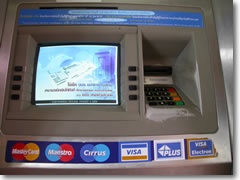ATMs—Cheapest money changers on the road
The easiest way to carry money abroad, especially in Europe, is the same way you do at home: Simply use the ATM card linked to your home checking account to get local cash—Euros or Pounds—out of street corner ATMs
 ATMs (cash machines) look the same all around the world—even this one in Thailand—and any one that displays the stickers of all the major cards and networks will most likely accept your home bank card.
ATMs (cash machines) look the same all around the world—even this one in Thailand—and any one that displays the stickers of all the major cards and networks will most likely accept your home bank card.
If you're on the MasterCard/Cirrus or Visa/Plus networks—and virtually all bankcards are, whether your local system is called Mac or Star or whatever (look for the name and symbol on the back of the card)—then you will be able to get cash out of foreign ATM machines or cashpoints.
Cash machines are almost universally called " bancomat ," and as in the U.S., you can find one on almost every block in major cities, and on the main squares or drags in smaller towns. All of them come equipped with an ATM machine willing to spit out local cash just as soon as you stick in your bank card and enter your PIN.
If you have trouble finding one, just ask for a "bancomat" (Euro-speak for ATM). Virtually all ATMs will accept a card from any of the major networks, so you really don't need the automated locators provided by:
- MasterCard/Cirrus (www.mastercard.com/atmlocator) and
- Visa/Plus (visa.via.infonow.net/locator/global/jsp/SearchPage.jsp)
Why an ATM is the best way to get local currency
Creeping bank fees
I have heard that some American banks have begun charging a higher fee for international withdrawals. Sadly, many U.S. banks are also now charging an additional "foreign exchange" fee for withdrawing money abroad—even though it doesn't cost them a single cent (or euro) extra; it's just a way of stealing more money from you.
Ask your local bank before traveling to avoid a nasty surprise—and consider using a credit union or other bank that will not charge these kinds of fees.
You can get much more on this (and other financial issues) at the excellent financial planning site BankRate.com (bankrate.com) and at this wiki on FlyerGuide.com.The reasons to use an ATM (over any other method of getting cash abroad) are legion.
There's no more in line at the bank window or at the local American Express office, handing over your passport in order to cash traveler's checks then forking over a commission of 10% or so. With an ATM, you just saunter up, stick in your card, punch in the PIN, and it spits out local cash, just like at home.
Best of all, the cash comes at a lower exchange rate and, unless your bank at home charges you for out-of-network withdrawals (most do, at $1 to $4; some smaller local banks and credit unions do not), there's no commission, as European banks have not yet hit upon this method of nickel-and-diming us out of that extra $2.
There are a few pointers to keep in mind when it comes to using a cash machine in Europe:
- Make sure it's linked to your checking account, as some banks won't let you withdrawal from your savings account at foreign ATMs.
- Make sure your PIN is only 4 digits long (not six), as some European banks won't accept longer ones.
- Make sure you let your bank know you'll be making foreign withdrawals. Banks sometimes have automated software that looks for suspicious usages that might imply theft—i.e. you card is suddenly used for lots of withdrawals, far from home, for larger than usual amounts—and freezes your account to protect you. That’s very nice...unless you are the one making larger than usual withdrawals far from home!
- Know that you will get an even better rate (an average of 9% better) if you avoid using ATMs and cash at all and instead use a credit card wherever possible.
Related articles |
|
This article was by Reid Bramblett and last updated in November 2011.
All information was accurate at the time.
Copyright © 1998–2013 by Reid Bramblett. Author: Reid Bramblett.
